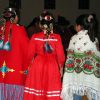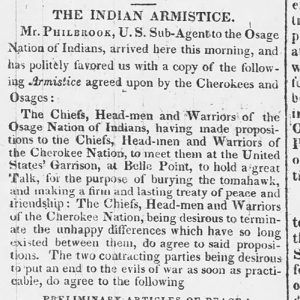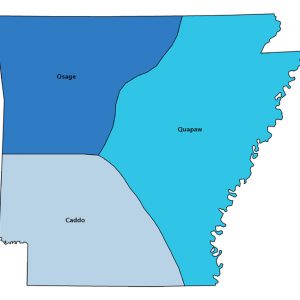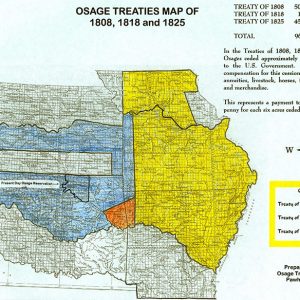calsfoundation@cals.org
Osage
The Osage lived in several villages located in southwest Missouri when Europeans began to explore and settle the lands west of the Mississippi River late in the seventeenth century. During this period, Osage hunters made frequent forays into northwest Arkansas, but, more importantly, their role as key players in economic and political affairs before the modern era touched the lives of nearly everyone living in the region.
The Osage language is one of the Dhegiha dialects of the Siouan language family, closely related to languages spoken by members of the Quapaw, Omaha, Kansa (or Kaw), and Ponca tribes. Archaeologists have not identified the pre-Columbian ancestors of the historic Osage, but oral traditions and the mutually intelligible character of Dhegihan dialects suggest a movement of all these groups into the region from the Mississippi or Ohio river valleys, perhaps as late as the sixteenth century. Osage share many cultural features with their linguistic relatives, including the tracing of one’s lineage through the father’s line, the organization of kindred into two main divisions of clans known as the Earth People and the Sky People, and the devotion of community life to principles bequeathed to humans by a mysterious creative force called Wakondah.
Osage attribute their origins to events associated with Wakondah’s separation of air, earth, and water from the primordial Middle Waters. Thus the universe consists of the earth (Hunka) and sky (Tsi-zho), with earth further separated into land (Hunka) and water (Wa-sha-she). Humans and other living species inhabit a narrow stratum between earth and sky, called hó-e-ga (the trap ensnaring all of life). This plane of existence also consisted of two interconnected realms: a visible world in which things take physical form, and an invisible world of creative powers and spiritual forces. Nineteenth-century anthropologists documented twenty-four clans divided among the Earth and Sky People divisions.
Osage villages came to be organized in relation to principles established in this story. The leaders of the Sky People and the Earth People built their houses on opposite sides of a road representing the path of the sun as it traverses the sky from sunrise to sunset. Clan groups arranged their houses on alternate sides of the path, extending out from their leaders’ residences. Multiple families, related through the male line, occupied rectangular longhouses built of pole frameworks covered with bark sheets. Villages also contained small, circular sweat houses and large meeting houses. Crop fields surrounded the permanent villages, beyond which extended game-filled forests and prairies.
Osage organized the annual cycle of activities in these early villages around a calendar of seasonal agricultural and hunting activities. They cleared agricultural fields in the spring, and the women of each household tended their own crops of corn, beans, squash, and pumpkins. Throughout the year, women also collected a variety of wild plant foods, including nuts, fruits, and edible roots, some of which they parched over fires or dried and stored for winter use. Meanwhile, men hunted deer, antelope, bear, and smaller game. After the crops were established, many families left their permanent villages and moved west onto the plains of Kansas and Nebraska for a summer buffalo hunt. Members of different clans occupied the same positions relative to one another in temporary hunting camps as in the permanent villages. Buffalo hunting was carefully organized under the command of experienced leaders, and each person—men, women, and children—was assigned a specific role in an overall strategy executed with military precision. This hunt, and another one carried out in the late fall, provided abundant meat, hides, and other resources to support the village economy and to provide extra commodities for trade. In between these two hunts, people returned to the main villages to harvest and store their crops. Family groups then spent winters in camps distributed throughout southwest Missouri and northern Arkansas, along rivers with plentiful supplies of game and firewood. As winter gave way to spring, families moved back to the main villages to begin the cycle again.
Village life was full of activity. Women cared for the food stores, cooked meals, and manufactured clothing and most of the tools, utensils, and furnishings used in and around the houses. When men were not out hunting, they maintained their supplies of bows and arrows and other equipment and crafted a variety of ritual objects. Adults and elders also looked after the children, patiently instructing them in the Osage way. This they undertook with considerable devotion because children were identified as sacred bearers of the Osage future. Social activities also provided daily opportunities for village residents to discuss and evaluate events from the recent and the more distant past, in order to plan ongoing and future activities.
Osage performed daily ceremonies—large and small, public and private—in connection with nearly every activity, because all activities triggered the dynamic relationship between the visible and invisible realms of existence. Hunting, harvesting crops, collecting plant foods, waging war against enemies, consecrating alliances with friends, healing illnesses, and even manufacturing the necessities of life brought eternal life forces into play, thereby necessitating the performance of sacred rituals. Osage also performed ceremonies in connection with important life events, including birth, adoption, achievement of adulthood, marriage, and death.
Many ceremonies were public events performed by the clans. Each clan had specific ceremonial responsibilities that could only be completed with assistance from a partner clan belonging to the opposite clan division. A group of elders known as the Little Old Men maintained rules and customs followed in ritual and in most other aspects of community life. The Little Old Men were careful observers of nature and assiduous collectors of information acquired by other community members. Attention was paid to heavenly objects moving across the daytime and nighttime skies in recurring patterns; to the seasonal cycle of weather patterns, plant growth, and animal behavior; to the changing patterns of landforms and water bodies; to the cycles of human growth and development; and, especially, to the interconnectedness of each of these patterns. Thoughtful analysis of this information yielded a philosophy based on the orderly nature of the universe that defined the role of people as responsible participants in the ongoing cycle of life.
European explorers and settlers entered the area the Osage inhabited toward the end of the seventeenth century. In a replay of the primordial alliance between the Sky People and the Earth People, French and Spanish colonists and their Osage hosts discovered mutual benefits in alliance and cooperation. The Osage provided information about lands and inhabitants west of the Mississippi River and were a ready source for food, hides, and other commodities required for the survival of the first European settlements. In return, the Osage received access to horses and manufactured trade goods, including firearms and ammunition, and a wide range of other items including tools, clothing, and household furnishings. Their position astride the Mississippi River Valley and the Great Plains conferred on Osage villages a great advantage as colonial trade systems developed, enabling them to control the movement of Indian and European commodities between the two regions. The Osage consequently built a strong trade empire, capable of withstanding the challenges of competitors and greatly extending the geographical area under their control.
The mutually dependent relationships that sustained the Osage and their Euro-American allies ended with the 1803 Louisiana Purchase. The U.S. government was interested not in sustaining economic and political partnerships with Indian nations but rather removed Indians from lands both east and west of the Mississippi River now opened for white American settlement. This policy thrust the Osage into conflicts with neighboring tribes.
Forced to cede their indigenous homelands via treaties signed in 1808, 1818, and 1825, the Osage relocated to the Three Forks area of eastern Oklahoma. Meanwhile, Cherokee settling in increasing numbers along the Arkansas River between present-day Morrilton (Conway County) and Fort Smith (Sebastian County) began to encroach on lands north of the river the Osage still claimed. This led to a number of violent conflicts between the tribes, in response to which Major William Bradford and a company of U.S. Army soldiers arrived at Belle Point along the Arkansas River in December 1817 to begin construction of Fort Smith. This show of force prompted Osage and Cherokee delegations to meet the following summer in St. Louis, Missouri, with Missouri territorial governor William Clark, who served also as the territorial supervisor of Indian Affairs. Clark negotiated a truce, part of which involved the Osage selling a tract of land extending north of the Arkansas River from Frog Bayou to the Verdigris River, known as “Lovely’s Purchase,” intended to serve as a buffer between the tribes. Ultimately this truce failed, and Osage and Cherokee violence continued for several years until another treaty was signed, this time at Fort Smith, in August 1822.
In the years that followed, the extermination of buffalo herds coupled with a greatly reduced land base on their Oklahoma reservation plunged the Osage into an impoverished state. The federal government provided only limited assistance as part of a larger program aimed at transitioning Indian families to a rural American farming lifestyle. Many elements of Osage culture eroded, including their clan organization and associated social and religious institutions. In their place, Osage accepted other institutions that enabled them to endure an era of pronounced cultural oppression. In 1884, the Osage adopted the E-Lon-schka dance from the Kansa Indians, which, through celebration of the achievement of adulthood by a family’s oldest son, helped preserve the traditional patrilineal social organization. In 1898, the Osage adopted the “Big Moon” peyote religion introduced by the Caddo–Delaware prophet John “Moonhead” Wilson. Combining elements of Christian and traditional Native American religious beliefs, peyote religion helped preserve ancient beliefs in the ties connecting human communities with eternal spiritual powers.
Discovery of oil reserves beneath their Oklahoma lands in the early twentieth century brought unprecedented wealth to the Osage, who, for a time, became popularly known as the “richest people in the world.” While such wealth enabled many to partake in material excesses—such as owning expensive cars and lavish residences—enjoyed by other well-to-do people of the era, the most far-reaching impact was to propel ever-growing numbers of Osage into wider participation in mainstream American culture. Even so, the Osage identity is preserved today through participation in language and cultural preservation activities, museum programs, the E-Lon-schka dances, and other community ceremonies. Established in 1938, the Osage Tribal Museum in Pawhuska, Oklahoma, is the oldest tribally owned museum in the United States.
In 2023, at the request of the Osage, the U.S. Geological Survey named the highest peak in the Ozark Mountains, located in Newton County, Wahzhazhe Summit, using the traditional name of the tribe.
For additional information:
Bailey, Garrick, ed. The Osage and the Invisible World: From the Works of Francis La Flesche. Norman: University of Oklahoma Press, 1995.
Bailey, Garrick, and Daniel C. Swan. Art of the Osage. Seattle: St. Louis Art Museum in Association with the University of Washington Press, 2004.
Bauer, Frankie. “Civilized Settlement and Nomadic Dominion: Inter-Tribal Treaties and Grand Councils between the Cherokee and Osage Indians, 1817–1828.” MA thesis, Western Carolina University, 2018.
Bergherm, Brent Gary. “The Little Osage Captive: The Tragic Saga of Lydia Carter.” Arkansas Historical Quarterly 62 (Summer 2003): 123–152.
Bolton, S. Charles. Arkansas, 1800–1860: Remote and Restless. Fayetteville, University of Arkansas Press, 1998
Burns, Louis F. A History of the Osage People. Tuscaloosa: University of Alabama Press, 2004.
Cash, Jon D. “Removal of the Quapaw and Osage.” Arkansas Review: A Journal of Delta Studies 48 (December 2017): 163–179.
DuVal, Kathleen. The Native Ground: Indians and Colonists in the Heart of the Continent. Philadelphia: University of Pennsylvania Press, 2006.
Edwards, Tai S. Osage Women: Gender and Power. Lawrence: University Press of Kansas, 2018.
Osage Nation. https://www.osagenation-nsn.gov/ (accessed March 28, 2022).
Rollings, Willard H. The Osage: An Ethnohistorical Study of Hegemony of the Prairie-Plains. Columbia: University of Missouri Press, 1992.
George Sabo III
Arkansas Archeological Survey
 Native Americans
Native Americans Armistice Story
Armistice Story  Indian Extents Map
Indian Extents Map  Osage Treaties
Osage Treaties  Osage Indians
Osage Indians 



Comments
No comments on this entry yet.